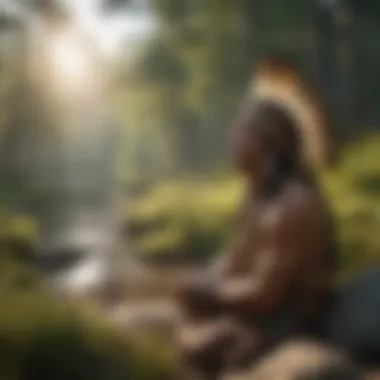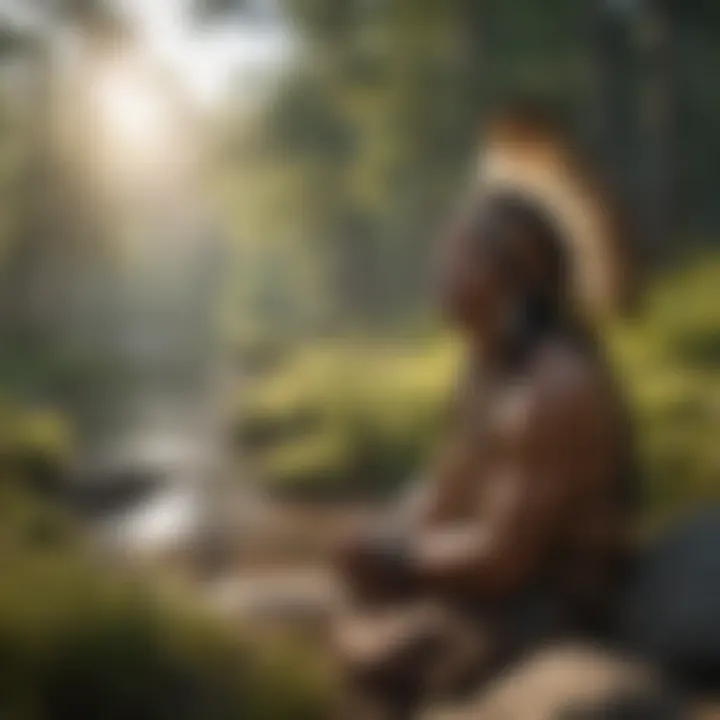Wisconsin Native American Tribes: Heritage & Nature


Nature Topic Overview
When we talk about Wisconsin, we can't overlook the Native American tribes who have lived on this land for centuries. These tribes, like the Ojibwe, Oneida, and Menominee, have stories that are tightly woven into the natural landscape of the state. Their cultures, practices, and knowledge are deeply connected to the rivers, forests, and lakes of Wisconsin. This article is a journey through the rich tapestry of these tribes, their experiences, and how they relate to their environment.
Understanding these unique tribes not only helps us appreciate their vibrant cultures but also shows us the important role they play in conserving nature. As we dive in, we'll look at some fun facts, wildlife explorations, and DIY activities that can spark curiosity and respect for these fascinating communities.
Fun Facts and Trivia
Let’s sprinkle in some interesting tidbits that will surely catch the eye of our young readers:
- The Ojibwe are known for their beadwork and colorful art, often inspired by stories and dreams.
- Many Wisconsin tribes call themselves the “People of the Earth,” highlighting their deep connection to nature.
- The Menominee tribe successfully saved the oldest tree in the world, the Ancient White Cedar, from being cut down.
To make learning more fun, why not create a fact sheet to share? Kids can jot down what they find cool about each tribe and where they see these connections in the world around them.
"Nature is not a place to visit. It is home."
- Gary Snyder
Wildlife Explorations
Wisconsin is home to an array of wildlife that the Native American tribes have coexisted with for generations. For instance:
- Bald Eagles: Known as symbols of strength and freedom, these majestic birds are often found near lakes where they hunt for fish.
- White-tailed Deer: A vital source of food and material for many tribes, deer are often seen roaming the forests and fields.
- Wild Rice: This aquatic plant is not just a food source; it's a traditional staple for many tribes, gathered during the autumn months.
To engage young minds, activities like creating a wildlife bingo can be exciting! Kids can mark off animals they see when visiting nature parks or their own backyards.
Environmental Awareness
Teaching kids about the importance of respecting and preserving the environment goes hand in hand with understanding Native American culture. Here are a few ideas:
- Conservation Matters: Native tribes believe that every action we take affects the environment. Even small changes can make a big difference!
- Simple Tips for Kids:
- Always recycle paper and plastic.
- Start a small garden to learn how plants grow.
- Take part in community clean-ups to beautify local parks.
Creating awareness early on fosters a responsible attitude in future generations. Learning from the wisdom of Wisconsin tribes can guide us in nurturing our planet.
DIY Nature Activities
Here are some engaging activities for kids to connect with nature and the culture of Native American tribes:
- Create Your Nature Journal: Gather leaves, flowers, or even pebbles. Kids can write down their observations and draw pictures related to their findings.
- Craft Your Own Dreamcatcher: Using simple materials like twine, feathers, and beads, children can make their versions of this traditional artifact, learning about its significance as they craft.
- Nature Scavenger Hunt: List items found in nature, like specific leaves, rocks, or flowers. This outdoor exploration encourages them to pay attention to their surroundings.
These projects not only stimulate creativity but also build appreciation for nature and Indigenous cultures.
In summary, understanding Wisconsin's Native American tribes offers us a deeper connection to both culture and environment. Through engaging activities, fun facts, and awareness, we can inspire children to respect and celebrate the rich heritage of these tribes while embracing the beauty of nature.
Prologue to Native American Tribes in Wisconsin
The story of Native American tribes in Wisconsin is like a vibrant tapestry woven from countless threads of history, culture, and nature. Understanding these tribes is vital, not just for appreciating Wisconsin's rich heritage but also for recognizing the unique contributions these communities offer to the broader narrative of American history. Through examining their customs, beliefs, and relationships with the land, we gain insights into how these tribes have thrived amidst changes and challenges.
Overview of Wisconsin's Indigenous Peoples
Wisconsin is home to several Indigenous peoples, each with its distinct identity and way of life. Historically, the land was inhabited by numerous tribes, including the Ojibwe, Ho-Chunk, Menominee, Oneida, and Potawatomi. These tribes have been living on these lands for thousands of years, often organized in a intimate relationship with nature. Their understanding of the local environment is profound, as peaks, valleys, rivers, and forests are not just landscapes but are deeply woven into their traditions and survival.
The Ojibwe, for instance, have rich oral traditions that tell stories of their origins and their connections to the lakes, which are often viewed as sacred. This includes not just reverence for these waters but an understanding of their ecosystem.
In contrast, the Ho-Chunk tribe speaks of their genesis in the region with deep connections to specific geographical markers that represent their heritage. These narratives ensure survival through oral recitation, reminding younger generations about their lineage and home.
Cultural Diversity Among Tribes
The cultural diversity among Wisconsin’s Native American tribes reflects varied languages, practices, and value systems. Each tribe offers unique perspectives, which is an essential element of understanding their communities. The Ojibwe language, for instance, is vital for preserving cultural knowledge, while the Ho-Chunk people actively practice their rites and ceremonies to keep their traditions alive.
With each tribe maintaining distinct customs, the differences should be cherished.
- Ojibwe Tribe: Known for their intricate beadwork and wild rice harvesting, their artistry is closely linked with their identity.
- Ho-Chunk Nation: Their language and traditional foods encapsulate their cultural essence, with a focus on storytelling as a means of tradition.
- Menominee: They are noted for their forest-based practices, embodying balance and respect for natural resources.
Understanding the diversity among these tribes helps in appreciating their resilience and adaptability over generations. Their culture is impacted by history, yet they continue to thrive and share the knowledge gained throughout time. Through acknowledging their differences, we also spotlight their common goal: the preservation of their heritage and connection to Wisconsin's majestic landscape.
"Nature is a testament to our history; every tree, river, and hill carries our stories. Without understanding them, we risk losing a vital part of ourselves."
Diving into this exploration invites us to appreciate and learn from these communities, enriching both our lives and knowledge about Wisconsin's Indigenous peoples.


Major Tribes in Wisconsin
Wisconsin is home to a variety of Native American tribes, each with its own rich history and culture. Understanding the major tribes provides a deeper insight into the tapestry of Wisconsin's Indigenous heritage. The tribes are not just groups of people but also a community that possesses unique languages, customs, and connections to the land. By exploring these tribes, we can appreciate the distinct ways they navigate modern life while maintaining their cultural integrity.
Ojibwe Tribe
History and Resilience
The Ojibwe tribe, known also as the Chippewa, boasts a long history marked by resilience. This tribe, one of the largest in the United States, has seen countless challenges over centuries, from forced relocations to battles for treaty rights. The perseverance of the Ojibwe people is often highlighted by their continuous efforts to reconnect with their heritage. Their drive to maintain their traditions while adapting to contemporary times is truly a testament to their strength. One important aspect is their establishment of tribal schools that incorporate language and cultural studies, ensuring the youth stay grounded in their roots.
Traditional Practices
Ojibwe traditional practices are deeply entwined with their identity. From the crafting of birchbark canoes to wild rice gathering, these age-old practices illustrate their intimate relationship with nature. The Ojibwe emphasize community gatherings during seasonal changes, celebrating the cycle of life through rituals. One unique feature of these practices is the spiritual significance placed on every act, whether it be a fishing expedition or a storytelling session. These practices not only keep traditions alive but also foster a sense of belonging and collective responsibility among members.
Contemporary Challenges
The contemporary challenges faced by the Ojibwe tribe include issues such as environmental degradation and economic difficulties. Changes in land use and climate patterns endanger their natural resources, notably wild rice beds, which are fundamental to their way of life. Despite these challenges, the tribe actively engages in advocacy for environmental protection. Their ability to collaborate with other organizations for sustainable solutions showcases their resolve to overcome hurdles while striving to preserve their cultural identity.
Ho-Chunk Nation
Cultural Practices and Language
The Ho-Chunk Nation is rich in cultural practices, which include vibrant ceremonies and unique languages. Their language, which has seen revitalization efforts, serves as a crucial tool for cultural expression. One of the significant characteristics of Ho-Chunk culture is the emphasis on oral history and storytelling, which passes down traditions through generations. Engaging with their stories, especially among younger members, deepens their understanding of identity. This means that these cultural practices aren’t just relics of the past; they’re living, dynamic aspects of life today.
Economic Initiatives
Economically, the Ho-Chunk Nation has displayed innovation through various initiatives. Their ventures in tourism and gaming have created opportunities for job growth and income. One standout characteristic is their commitment to social responsibility, as profits from these initiatives often fund health and education programs for tribal members. However, this growth comes with challenges as they navigate the complexities of market changes and political climates.
Preservation of Tradition
The preservation of tradition within the Ho-Chunk Nation symbolizes their strength in identity. Cultural events, art, and community activities work hand-in-hand to keep traditions alive. The unique feature here lies in their adaptability; while they uphold their traditions, they also blend in modern societal elements, allowing for both growth and cultural continuity. Balancing these aspects can be tricky. Yet, their resilience shines through in their ongoing efforts to instill a sense of pride in both of their heritage and modern accomplishments.
Menominee Indian Tribe
Forest Management Practices
The Menominee Indian Tribe manages their surrounding forests with incredible care, rooted in their respect for nature. Their forest management practices are often celebrated as a model of sustainability. One key characteristic is their commitment to holistic practices that ensure the forest’s health for generations to come. This integrated relationship nurtures not only the ecosystem but also the cultural ties to the land, showcasing how traditional knowledge is harmonized with modern conservation techniques. It proves beneficial as they strive for balance between preservation and economic development.
Cultural Reclamation
Cultural reclamation for the Menominee Tribe emphasizes rediscovery and revitalization of their heritage. This aspect is crucial, especially in an age where many Indigenous traditions risk fading into obscurity. Their unique focus lies in reviving their language and incorporating traditional knowledge in modern settings. It brings both advantages and challenges: while the collectivization of cultural identity strengthens community bonds, the effort requires time and resources that can at times be limited.
Inter-Tribal Relations
Menominee's relations with other tribes illustrate the importance of community. Collaborative efforts among tribes to address common issues, such as environmental challenges or cultural preservation, can bridge gaps and create a stronger unified voice. One of the distinct features is their joint events and conferences to share knowledge. Yet, like with any community effort, differences in opinion can emerge, which requires open dialogue and mutual respect.
Oneida Nation
Historical Significance
The Oneida Nation holds a significant place in the history of Indigenous peoples in Wisconsin. Known for their involvement in the American Revolution, their contributions show a blend of adaptability and strength. Their rich history offers lessons on cooperation and survival. Their deep understanding of negotiation extends to modern treaty rights, reflecting their foundational role in both local and national contexts. One unique aspect is how they document their history, ensuring their stories and sacrifices are recognized and honored.
Agricultural Contributions
The Oneida Nation has made considerable agricultural contributions, notably in the realm of traditional farming practices and modern techniques. They advocate for sustainable practices that respect the land. This unique feature puts emphasis not only on crop production but also on the rejuvenation of soil health and biodiversity. This blending of old traditions with new methods not only boosts their economy but also engages community members in meaningful ways.
Modern Governance
Modern governance within the Oneida Nation demonstrates a model of self-determination and community engagement. Their political structure, based on democratic principles, allows members to have a say in increased development and welfare initiatives. The key characteristic of their governance stems from an inherent understanding of cultural values. While they thrive, the balance of tradition with modern legal and economic pressures poses ongoing challenges. Nevertheless, the Oneida remain committed to ensuring their future is brighter and more prosperous.
Potawatomi Tribe
Cultural Heritage
The Potawatomi Tribe's cultural heritage is rich and multifaceted. It encompasses not just story and dance but also the intricate basket weaving and food practices that have been passed down for generations. One unique aspect of their heritage is the role of the land in shaping their culture, particularly their connection to the Great Lakes. This heritage enhances their identity and contributes to a strong community spirit, yet the external societal challenges sometimes complicate their preservation efforts.
Festivals and Ceremonies
Festivals and ceremonies play a pivotal role in community bonding among the Potawatomi. Celebrating a variety of seasonal events, such as the Green Corn Festival, strengthens their ties to the land and each other. This aspect of Potawatomi life not only showcases their rich traditions but also raises cultural awareness to insiders and outsiders alike. These celebrations serve both to teach the younger generation and to foster unity, yet organizing such events reliably can pose challenges.
Community Development
The Potawatomi emphasize community development with a focus on sustainability and self-sufficiency. Their initiatives about education, health, and economic stability are tailored to the needs of the community. One standout feature of their approach is the incorporation of cultural elements into development strategies, which enhances their distinct identity. However, navigating broader economic factors can lead to hurdles for ensuring long-term success in these initiatives.


The Role of Nature in Tribal Life
Nature plays a critical role in the lives of Wisconsin Native American tribes, profoundly influencing their cultural practices, beliefs, and daily existence. From the lush forests to the sparkling lakes, the natural environment shapes everything from the food they eat to their stories and traditions. Understanding this connection not only highlights the importance of nature to these communities but also sheds light on how respecting and caring for the environment is deeply rooted in their cultural identities.
Traditional Ecological Knowledge
Wisconsin’s tribes possess an invaluable knowledge system that combines observations passed down through generations with experiences gained through interaction with the land. This is often referred to as Traditional Ecological Knowledge (TEK). It involves practices like seasonal hunting, fishing, and gathering, which reflect a comprehensive understanding of the ecosystem.
For instance, the Ojibwe tribe employs a method called wild rice harvesting, which is done during a specific period each year. They know that rice grows best in shallow waters, and they gather it in a way that helps sustain future crops. This method not only provides food but also demonstrates a harmonious relationship with nature—showing reverence for resources that need to be protected and cherished.
Sacred Sites and Natural Resources
The land is dotted with sacred sites that hold special significance for tribes. These places are often viewed as powerful landscapes, where the spirit of the ancestors resides. They might include ancient birch trees or the shores of round lakes, each linked to stories that impart values and lessons to the youth.
Natural resources are not just provisions; they signify a deeper connection between the tribe and their heritage. Many tribes regard riverbanks or mountain tops not just as geographical features but as living entities in a spiritual sense. The Ho-Chunk Nation, for example, protects these locations vigorously, understanding that they symbolize their identity and are integral to maintaining cultural continuity.
Conservation Efforts by Tribes
Modern times have ushered in challenges for the environments that tribes call home. However, many tribes are at the frontline of conservation efforts. Whether it's restoring wetlands, planting native species, or cleaning up polluted waterways, they actively work to protect their natural surroundings.
A notable example includes the Menominee Indian Tribe, which has been recognized for its sustainable forestry practices, maintaining the timber supply without compromising the forest's health. This illustrates how ancient wisdom can harmonize with contemporary environmental science.
"Nature can provide the pathways to recovery; it's all about the relationship we choose to foster with it."
Through these concerted efforts, tribes demonstrate their ongoing commitment not only to their cultural heritage but also to preserving the environment for future generations. The teachings imparted through community initiatives ensure that children learn the importance of wildlife, water, and soil management from an early age, ensuring that the connection remains strong.
Cultural Practices and Language Preservation
Cultural practices and language preservation hold a cornerstone position in the identity of Wisconsin's Native American tribes. These elements are not just remnants of the past; they represent the living legacy that shapes the identities of the tribes today. Engaging with these practices enriches the community and continues the flow of knowledge to younger generations.
Traditional Storytelling
Storytelling is an age-old practice among Native American tribes in Wisconsin, acting as a vessel for both education and cultural transmission. Legends and tales often feature characters like trickster animals or spirits, embodying morals that teach life's lessons.
Stories serve as a memory bank where history, folklore, and values come alive. They are shared around the fire, invoking a sense of unity and belonging. Tribal elders play an essential role in this tradition, ensuring that stories retain their essence and fidelity through generations.
"Stories are like seeds, each holding the promise of growth and understanding."
These narratives often explain the natural world, providing insight into tribal relationships with nature. By recounting how their ancestors interacted with the land, these stories create a strong understanding among children about their responsibilities as guardians of the environment.
Role of Arts and Crafts
The arts and crafts of Wisconsin tribes serve as another critical channel for cultural expression and identity. Be it intricate beadwork, wood carvings, or pottery, these crafts are more than just aesthetic objects; they are artifacts steeped in meaning and history. Each pattern or design holds significance, often representing tribal ties and life experiences.
Art is also a conduit for language, with many tribal names and terminologies woven into the designs. For instance, motifs might reflect local flora and fauna, and each piece can tell a story in the right context. When children engage in these crafts, they learn about the language and the stories behind them, as well as develop fine motor skills and patience.
In addition to this, community art projects often unite tribes, fostering collaboration and cultural pride while ensuring new generations appreciate the traditional crafts.
Efforts in Language Revitalization
Language revitalization is another fundamental aspect of cultural preservation. Many tribes in Wisconsin face challenges in keeping their languages alive due to historical suppression and modern influences. Efforts to teach Indigenous languages in schools have become increasingly common, as educators understand the value of bilingualism.
Programs often include:
- Language classes that focus on conversational skills.
- Multimedia resources, such as apps and videos, that make learning engaging for younger audiences.
- Community events where native speakers gather to converse and transmit their language skills.
Bringing the language back into daily use is critical; it reaffirms identity and fosters a deeper connection to heritage. It not only helps preserve history but also enriches the cultural fabric of Wisconsin's tribes.
Overall, the intertwining of cultural practices and language not only sustains the past but also prepares the tribes for a vibrant, interconnected future.
Education and Youth Engagement
When it comes to the education of young minds, especially regarding the rich tapestry of Wisconsin's Native American tribes, the role of education and youth engagement coudn't be more pivotal. Both concepts serve as beacons, shining a light on the cultural, historical, and environmental wisdom that these tribes hold. Educating the youth about these tribes contributes to a broader understanding and appreciation of cultural heritage, which can lead to a more inclusive society.
Cultural Education Programs
Cultural education programs are the cornerstone of engaging young folks with the fascinating world of Native American tribes in Wisconsin. These programs dive into history, crafts, traditions, and storytelling, bringing to life what it means to belong to such a vibrant heritage. Programs might include workshops where children can learn traditional art forms like beadwork or basket weaving, essential skills that have been passed down through generations.
Moreover, many tribes organize summer camps where kids get to experience the outdoors while learning about their ancestors’ connection to nature. In these settings, elders share legends and lore that keep the culture alive and relevant. They are not just stories, but lessons that echo resilience and adaptation, crucial for today’s world. Giving children a chance to learn from the elders positions them as stewards of their culture, instilling a sense of pride and responsibility at an early age.
"Education is not just preparation for life; education is life itself."
Importance of Nature-Based Learning


Nature-based learning embodies an essential element of education for children, particularly within Native American tribes. It’s about more than just being outside; it’s understanding the symbiotic relationship between humans and the natural world. This kind of learning teaches respect for the environment and emphasizes sustainability—a value that is deeply embedded in the traditions of Wisconsin tribes.
In outside classrooms, children engage with forests, rivers, and wetlands, recognizing them as resources to appreciate, not exploit. Educators within these programs often make the age-old connections between cultural practices and environmental stewardship. For instance, children learn about traditional practices such as harvesting wild rice, which involves understanding the cultural significance and ecological impact of the activity.
The benefits of nature-based learning stretch far beyond the classroom walls. It enriches the physical and mental well-being of children. Spending time in the great outdoors can lead to increased focus, better mood, and a deeper connection to their own community and heritage. Overall, this approach reveals the complexities of cultural identity tied to the natural world, ultimately supporting a future generation that values both their traditions and the landscapes they inhabit.
Modern Challenges Facing Tribes
Understanding the modern challenges faced by Wisconsin's Native American tribes is essential in recognizing how these communities navigate a changing world. These challenges, while often complex, also present unique opportunities for growth, resilience, and development within the tribes. Addressing these issues is not only vital for the tribes themselves but also for fostering, support and respect between the tribes and broader society.
Economic Challenges and Opportunities
Many tribes in Wisconsin face economic challenges that can hinder their growth and sustainability. Historically, these tribes have been subjected to various forms of economic displacement and marginalization, leading to significant issues such as poverty and unemployment within their communities. However, there are also opportunities that arise from these challenges.
For instance, some tribes are engaging in entrepreneurship, developing businesses such as casinos, tourism, and crafts that showcase their rich cultural heritage. These ventures not only provide jobs but also help to preserve traditions and educate the wider public about their history and culture.
Key factors to notice include:
- Increased job creation through tribal enterprises.
- Community reinvestment to uplift local economies.
- Collaborative projects with other businesses, creating partnerships for greater impact.
Environmental Concerns
Environmental challenges are particularly pressing for Native American tribes in Wisconsin. Issues like climate change, pollution, and loss of natural resources directly impact their way of life, affecting not just the environment but the cultural practices tied to it.
Tribes often rely heavily on the land for subsistence, traditional medicine, and cultural ceremonies. Therefore, when the environment suffers, so do tribal traditions. Many tribes are now taking initiative in conservation efforts, actively working to protect not just their natural resources, but the land that has historical significance to their people.
Their strategies can involve:
- Restoration projects for wetlands and forests.
- Protecting sacred spaces from industrial development.
- Advocacy for sustainable practices in local and state policies.
Protection of Cultural Heritage
The protection of cultural heritage is a crucial challenge that many Native American tribes face today. As modernization spreads, there is a constant risk of cultural erosion. Many traditions, languages, and histories are at risk of being forgotten.
However, tribes are actively championing the preservation and revitalization of their unique cultural identities. Initiatives include educational programs focusing on language classes, traditional crafts, and storytelling. Such efforts can effectively engage the younger generations, ensuring that the rich cultural tapestries of these tribes endure.
"To forget one's ancestors is to be a brook without a source, a tree without a root."
— African Proverb
Tribes are also working to secure legal protections for sacred sites and cultural artifacts, fighting against the appropriation of their knowledge. Efforts in this area not only seek to protect their past but also empower future generations to take pride in their heritage.
With continued awareness and support, these tribes can not only overcome challenges but also flourish, paving a path forward for future generations.
Future Perspectives
The future of Wisconsin's Native American tribes holds potential for growth and revitalization, especially as they adapt to modern challenges while asserting their cultural identity. This section explores how the tribes are navigating the complexities of contemporary life, focusing on their use of technology and the pivotal role of their youth in cultural stewardship. These future perspectives will not only define their path but also enrich the state’s cultural tapestry for generations to come.
Role of Technology in Preservation
In today's world, technology plays a significant role in preserving the vibrant cultures of Native American tribes. The incorporation of digital tools allows tribes to document stories, artwork, and traditions effectively. For instance, many tribes are using social media platforms to share their narratives and art forms, making them accessible to a broader audience. This can be crucial for driving awareness and appreciation among younger generations and outsider society.
Here are a few ways in which technology aids preservation:
- Digital Archives: Tribes create online databases to store audio recordings of traditional songs, stories, and interviews from elders. This helps ensure that cultural knowledge is not lost with the passing of generations.
- Online Education: Many tribes are developing e-learning platforms that link students to their cultural heritage, offering lessons on history, language, and traditional practices.
- Virtual Reality Experiences: Some tribes have begun using virtual reality to immerse participants in traditional ceremonies and landscapes, allowing people to experience Native American culture from anywhere in the world.
By embracing technology, these tribes not only safeguard their heritage but spice it up with modern touches, making it relevant in today’s fast-paced world.
Youth as Cultural Stewards
Youth engagement is vital for the continuation of cultural identity within Wisconsin's Native American tribes. Young members are often seen as guardians of their communities' knowledge and traditions, enabling the transfer of cultural practices to the next generation. This responsibility brings unique opportunities for growth and innovation.
Engaging youth in cultural stewardship can happen through a variety of channels:
- Workshops and Camps: Offering programs that teach traditional skills such as beadwork, drumming, and storytelling ensures that these practices are handed down.
- Mentorship Programs: Established elders mentor young people, sharing wisdom and insights into their heritage, strengthening the intergenerational connection.
- Cultural Gatherings: Involving youth in organizing and participating in tribal events can ignite pride in their identity while encouraging leadership skills.
Through these efforts, the youth become not just recipients but active participants in cultural preservation. They embody the spirit of their ancestors while adapting those lessons to present-day challenges.
“A tree does not grow in isolation; it thrives through its connection to the land and the community.”
End
Understanding the Native American tribes of Wisconsin is not just about history; it’s about recognizing the significant role these communities play in today's world. This article has taken a journey through the rich tapestry of their cultures, the challenges they face, and their deep connection to nature. Each element discussed holds importance that reaches far beyond the page. It's vital for children, educators, and parents to grasp the stories, struggles, and triumphs of these tribes.
Significance of Understanding Wisconsin Tribes
Gaining insight into Wisconsin's Indigenous peoples can enlighten us about varying ways of life and differing perspectives on community and nature. This understanding can foster appreciation and respect for cultural diversity. Here are a few aspects to consider:
- Cultural Heritage: Each tribe carries distinct traditions, languages, and histories. Learning about these enhances our awareness of the rich cultural landscape in Wisconsin.
- Environmental Wisdom: The tribes often embody a symbiotic relationship with nature, offering lessons in sustainability that are crucial in today’s world.
- Social Issues: Recognizing modern challenges faced by these communities can cultivate empathy and advocacy in young people, urging them to take part in positive change.
- Educational Enrichment: Exploring these cultures provides a multi-faceted learning experience. Children can link historical knowledge with contemporary realities, forming a more robust understanding of their own place in society.
By instilling the knowledge and history of Wisconsin's tribes into children’s learning, we lay the groundwork for a future where respect for diversity and environmental consciousness become second nature. That’s something every child, parent, and educator can carry forward into their lives.







